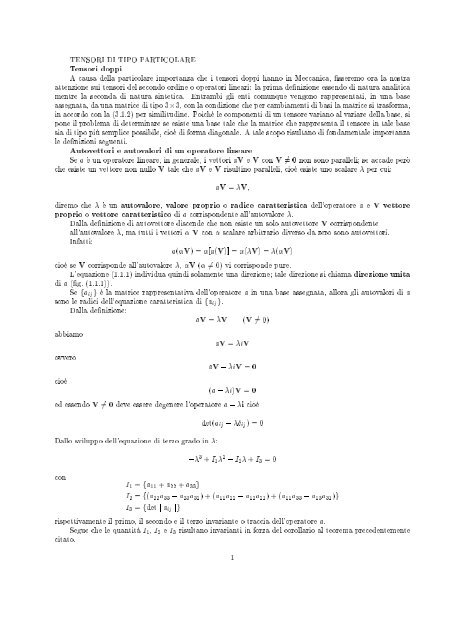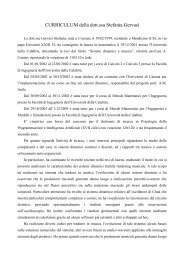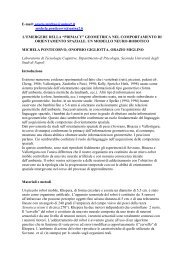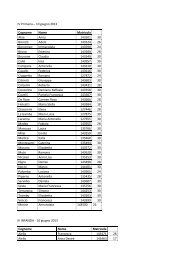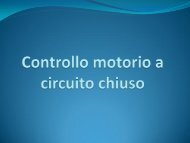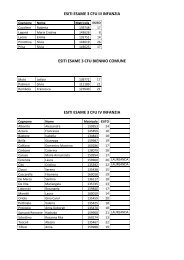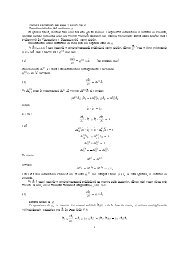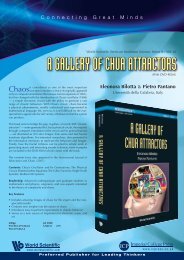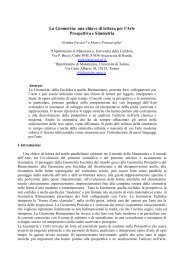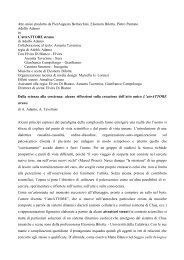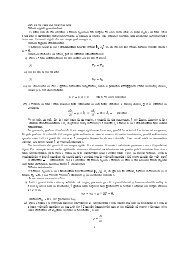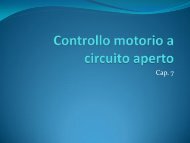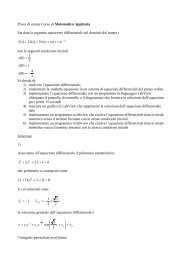Tensori doppi Autovettori e autovalori di un operatore lineare aV = V ...
Tensori doppi Autovettori e autovalori di un operatore lineare aV = V ...
Tensori doppi Autovettori e autovalori di un operatore lineare aV = V ...
You also want an ePaper? Increase the reach of your titles
YUMPU automatically turns print PDFs into web optimized ePapers that Google loves.
TENSORI DI TIPO PARTICOLARE<br />
<strong>Tensori</strong> <strong>doppi</strong><br />
A causa della particolare importanza che i tensori <strong>doppi</strong> hanno in Meccanica, sseremo ora la nostra<br />
attenzione sui tensori del secondo or<strong>di</strong>ne o operatori lineari: la prima denizione essendo <strong>di</strong> natura analitica<br />
mentre la seconda <strong>di</strong> natura sintetica. Entrambi gli enti com<strong>un</strong>que vengono rappresentati, in <strong>un</strong>a base<br />
assegnata, da <strong>un</strong>a matrice <strong>di</strong> tipo 33, con la con<strong>di</strong>zione che per cambiamenti <strong>di</strong> basi la matrice si trasforma,<br />
in accordo con la (3:1:2) per similitu<strong>di</strong>ne. Poiche le componenti <strong>di</strong> <strong>un</strong> tensore variano al variare della base, si<br />
pone il problema <strong>di</strong> determinare se esiste <strong>un</strong>a base tale che la matrice che rappresenta il tensore in tale base<br />
sia <strong>di</strong> tipo piu semplice possibile, cioe <strong>di</strong> forma <strong>di</strong>agonale. A tale scopo risultano <strong>di</strong> fondamentale importanza<br />
le denizioni seguenti.<br />
<strong>Autovettori</strong> e <strong>autovalori</strong> <strong>di</strong> <strong>un</strong> <strong>operatore</strong> <strong>lineare</strong><br />
Se a e <strong>un</strong> <strong>operatore</strong> <strong>lineare</strong>, in generale, i vettori <strong>aV</strong> e V con V 6= 0 non sono paralleli; se accade pero<br />
che esiste <strong>un</strong> vettore non nullo V tale che <strong>aV</strong> e V risultino paralleli, cioe esiste <strong>un</strong>o scalare per cui:<br />
<strong>aV</strong> = V;<br />
<strong>di</strong>remo che e <strong>un</strong>autovalore, valore proprio o ra<strong>di</strong>ce caratteristica dell'<strong>operatore</strong> a e V vettore<br />
proprio o vettore caratteristico <strong>di</strong> a corrispondente all'autovalore .<br />
Dalla denizione <strong>di</strong> autovettore <strong>di</strong>scende che non esiste <strong>un</strong> solo autovettore V corrispondente<br />
all'autovalore , ma tutti i vettori V con scalare arbitrario <strong>di</strong>verso da zero sono autovettori.<br />
Infatti:<br />
a(V) =[a(V)] = (V) =(V)<br />
cioe seVcorrisponde all'autovalore ; V ( 6= 0) vi corrisponde pure.<br />
L'equazione (1:1:1) in<strong>di</strong>vidua quin<strong>di</strong> solamente <strong>un</strong>a <strong>di</strong>rezione; tale <strong>di</strong>rezione si chiama <strong>di</strong>rezione <strong>un</strong>ita<br />
<strong>di</strong> a (g. (1.1.1)).<br />
Se fa ij g e la matrice rappresentativa dell'<strong>operatore</strong> a in <strong>un</strong>a base assegnata, allora gli <strong>autovalori</strong> <strong>di</strong> a<br />
sono le ra<strong>di</strong>ci dell'equazione caratteristica <strong>di</strong> fa ij g.<br />
Dalla denizione:<br />
<strong>aV</strong> = V (V 6= 0)<br />
abbiamo<br />
ovvero<br />
cioe<br />
<strong>aV</strong> = iV<br />
<strong>aV</strong> iV = 0<br />
(a i)V = 0<br />
ed essendo V 6= 0 deve essere degenere l'<strong>operatore</strong> a<br />
i cioe<br />
Dallo sviluppo dell'equazione <strong>di</strong> terzo grado in :<br />
det(a ij ij )=0<br />
3 + I 1 2 I 2 + I 3 =0<br />
con<br />
I 1 = fa 11 + a 22 + a 33 g<br />
I 2 = f(a 22 a 33 a 23 a 32 )+(a 11 a 22 a 12 a 21 )+(a 11 a 33 a 13 a 31 )g<br />
I 3 = fdet j a ij jg<br />
rispettivamente il primo, il secondo e il terzo invariante o traccia dell'<strong>operatore</strong> a.<br />
Segue che le quantita I 1 ;I 2 eI 3 risultano invarianti in forza del corollario al teorema precedentemente<br />
citato.<br />
1
Gli <strong>autovalori</strong> dell'<strong>operatore</strong> a possono essere tutti e tre reali, (eventualmente non <strong>di</strong>stinti) oppure due<br />
complessi coniugati e l'altro reale.<br />
Se l'<strong>operatore</strong> a ha tre autovettori U 1 ; U 2 ; U 3 <strong>un</strong>itari ed ortogonali, allora la matrice a ij che rappresenta<br />
a nella base<br />
fU 1 ; U 2 ; U 3 g<br />
e <strong>di</strong>agonale<br />
con (j) autovalore.<br />
Da:<br />
2<br />
3<br />
(1) 0 0<br />
a ij = 4 0 (2) 0 5<br />
0 0 (3)<br />
aU j = (j) U j<br />
segue:<br />
a ij =(aU j )U i = (j) U j U i = (j) ji<br />
(non si e fatto uso delle norme riguardanti l'uso degli in<strong>di</strong>ci ripetuti).<br />
Diagonalizzazione delle <strong>di</strong>latazioni ovvero dei tensori <strong>doppi</strong> simmetrici<br />
In generale non ogni <strong>operatore</strong> risulta <strong>di</strong>agonalizzabile, per esempio se ammette <strong>autovalori</strong> complessi;<br />
pero se esso e rappresentato da <strong>un</strong>a matrice simmetrica, cosa assai frequente in Meccanica Razionale, cioe<br />
l'<strong>operatore</strong> e <strong>un</strong>a <strong>di</strong>latazione, allora l'<strong>operatore</strong> e <strong>di</strong>agonalizzabile.<br />
In <strong>un</strong>a <strong>di</strong>latazione ad <strong>autovalori</strong> <strong>di</strong>stinti corrispondono autovettori ortogonali. Infatti se 1 e 2 sono<br />
<strong>autovalori</strong> <strong>di</strong>versi della <strong>di</strong>latazione e V 1 e V 2 due corrispondenti autovettori si ha:<br />
V 1 = 1 V 1 e V 2 = 2 V 2<br />
Moltiplicando la prima per V 2 e la seconda per V 1 a sinistra, abbiamo:<br />
ovvero, sottraendo membro a membro:<br />
cioe, per denizione <strong>di</strong> <strong>di</strong>latazione,<br />
ed essendo 1 6= 2 ,<br />
V 2 V 1 = 1 V 2 V 1 e V 1 V 2 = 2 V 1 V 2<br />
V 2 V 1 V 1 V 2 = V 1 V 2 ( 1 2 )<br />
V 2 V 1 V 1 V 2 =( 1 2 )V 1 V 2 =0<br />
V 1 V 2 =0<br />
cioe V 1 ? V 2 .<br />
Gli <strong>autovalori</strong> <strong>di</strong> <strong>un</strong>a <strong>di</strong>latazione sono tutti reali.<br />
Sia <strong>un</strong> autovalore della <strong>di</strong>latazione , allora<br />
U = U<br />
con U 6= 0 e <strong>di</strong> componenti eventualmente complesse. Se moltiplichiamo la (1:2:1) per U + (vettore le cui<br />
componenti sono le complesse coniugate <strong>di</strong> U),<br />
U U + = U U +<br />
con U U + numero reale. Quin<strong>di</strong> e reale se U U + e reale, cioe coincide con il suo coniugato. Facendo il<br />
coniugato <strong>di</strong> U U + , si ha successivamente:<br />
(U U + ) + = U + U<br />
= U + U<br />
(ereale!)<br />
2
per denizione <strong>di</strong> <strong>di</strong>latazione.<br />
Ogni <strong>di</strong>latazione e equivalente (simile) ad <strong>un</strong>a matrice <strong>di</strong>agonale.<br />
Il teorema e subito acquisito se gli <strong>autovalori</strong> dell'<strong>operatore</strong> sono <strong>di</strong>stinti (teorema (1.1.2)); se poi<br />
gli <strong>autovalori</strong> non sono <strong>di</strong>stinti il teorema varra lo stesso come si evince dall' esempio che seguira e dall'<br />
interpretazione geometrica che daremo della <strong>di</strong>latazione.<br />
Sia<br />
2<br />
4 3<br />
3<br />
0<br />
D ij = 4 3 4 05<br />
0 0 8<br />
la matrice rappresentativa della <strong>di</strong>latazione d rispetto alla base<br />
fC 1 ; C 2 ; C 3 g ;<br />
si determinino le <strong>di</strong>rezioni <strong>un</strong>ite <strong>di</strong> d e si <strong>di</strong>agonalizzi la matrice D ij .<br />
L'equazione caratteristica <strong>di</strong> D ij e:<br />
2<br />
3<br />
4 3 0<br />
det 4 3 4 0 5 =0<br />
0 0 8 <br />
(8 )[(4 ) 2 9]=0<br />
La (1:2:2) ammette come ra<strong>di</strong>ci: 1 =8e4<br />
=3 cioe<br />
n 7<br />
2;3 =43=<br />
1<br />
Gli autovettori <strong>di</strong> d corrispondenti a 1 ; 2 ; 3 sono:<br />
per 12 32<br />
3<br />
4 8 3 0 U 1<br />
4 3 4 8 0 54U 2<br />
5 =0<br />
0 0 8 8 U 3<br />
cioe: <br />
4U1 3U 2 =0<br />
3U 1 4U 2 =0<br />
ovvero <br />
4U1 +3U 2 =0<br />
3U 1 +4U 2 =0<br />
U 1 =0; U 2 =0 e U 3 =h arbitrario<br />
cioe:<br />
U 1 =(0;0;h);<br />
per 2<br />
32<br />
3<br />
4 7 3 0 U 1<br />
4 3 4 7 0 54U 2<br />
5 =0<br />
0 0 8 7 U 3<br />
cioe: (<br />
3U1 3U 2 =0<br />
3U 1 3U 2 =0<br />
U 3 =0<br />
ovvero (<br />
U1 U 2 =0<br />
U 1 U 2 =0<br />
U 3 =0<br />
U 1 = U 2 ; U 2 = k (arbitrario); U 3 =0<br />
3
cioe<br />
U 2 =( k; k; 0) ;<br />
per<br />
2 3 32<br />
3<br />
4 1 3 0 U 1<br />
4 3 4 1 0 54U 2<br />
5 =0<br />
0 0 8 1 U 3<br />
cioe:<br />
ovvero<br />
(<br />
3U1 3U 2 =0<br />
3U 1 3U 2 =0<br />
7U 3 =0<br />
(<br />
U1 U 2 =0<br />
U 1 U 2 =0<br />
U 3 =0<br />
U 1 =U 2 ; U 2 = i (arbitrario); U 3 =0<br />
cioe<br />
U 3 =(i; i; 0) :<br />
Le con<strong>di</strong>zioni <strong>di</strong> normalizzazione dei vettori U 1 ; U 2 ; U 3 che adesso in<strong>di</strong>chiamo con<br />
J 1 ; J 2 ; J 3<br />
danno:<br />
J 2 1 =02 +0 2 +h 2 =1=)h 2 =1=)h=1<br />
J 2 2 =k2 +k 2 +0 2 =1=)k 2 = 1 2 =)k= p<br />
2<br />
2<br />
quin<strong>di</strong>:<br />
J 2 3 =i2 +i 2 +0 2 =1=)i 2 = 1 2 =)i= p<br />
2<br />
2<br />
J 1 =(0;0;1); J 2 = <br />
p p !<br />
p p !<br />
2 2<br />
2 2<br />
2 ; 2 ; 0 ; J 3 = <br />
2 ; 2 ; 0 :<br />
La con<strong>di</strong>zione che la terna fJ 1 ; J 2 ; J 3 g deve essere positiva, permette <strong>di</strong> sciogliere l'ambiguita dei segni.<br />
Scegliendo i segni superiori in J 1 e J 3 e inferiori in J 2 abbiamo:<br />
2<br />
3<br />
p0 p0 1<br />
2 2<br />
0<br />
J 1 ^ J 2 J 3 = 6 2 2<br />
4 p p 7<br />
5 =<br />
2 2<br />
0<br />
22<br />
2<br />
p ! 2 p ! 3<br />
2 <br />
2 2<br />
2<br />
=14<br />
+ 5=1<br />
2 2<br />
4 4<br />
+2 = 4 4 =1<br />
In denitiva rispetto alla terna:<br />
J 1 =(0;0;1); J 2 =<br />
p<br />
2<br />
2 ; p<br />
2<br />
2 ; 0 !<br />
J 3 =<br />
p<br />
2<br />
2 ; p<br />
2<br />
2 ; 0 !<br />
4
la <strong>di</strong>latazione e rappresentata dalla matrice <strong>di</strong>agonale:<br />
2<br />
8 0<br />
3<br />
0<br />
4 0 7 05 :<br />
0 0 1<br />
Sia 2<br />
3<br />
4 0 p0<br />
4 0 p5<br />
3 5<br />
0 3 7<br />
la matrice che rappresenta la <strong>di</strong>latazione D nella base fC 1 ; C 2 ; C 3 g. Determinare le <strong>di</strong>rezioni <strong>un</strong>ite e la si<br />
<strong>di</strong>agonalizzi.<br />
L'equazione caratteristica della matrice e:<br />
2<br />
3<br />
4 0 p0<br />
det 4 0 5 p<br />
3 5 =0<br />
0 3 7 <br />
cioe<br />
(4 )[(5 )(7 ) 3]=0<br />
La (1:2:3) ammette come ra<strong>di</strong>ci =4e35 12 + 2 3 = 0 cioe<br />
2 12 +32=0<br />
<br />
=36 32=22<br />
4<br />
n 4<br />
=62=<br />
8<br />
ovvero<br />
1 =8; 2 = 3 =4;<br />
per 12 32<br />
3<br />
4 8 0 p0<br />
U 1<br />
4 0 5 p8<br />
3 54U 2<br />
5 =0<br />
0 3 7 8 U 3<br />
cioe: (<br />
4U1 =0 p<br />
p3U 2 3U3 =0<br />
3U2 U 3 =0<br />
ovvero (<br />
U1 =0<br />
3U 2 + p 3U 3 =0<br />
3U 2 + p 3U 3 =0<br />
U 1 =0; U 2 = k (arbitrario) U 3 = p 3U 2<br />
cioe<br />
U 1 =(0;k;<br />
p<br />
3k);<br />
per 2<br />
2<br />
3 2 3<br />
4 4 0 p0<br />
U 1<br />
4 0 5 p4<br />
3 5 4U 2<br />
5 =0<br />
0 3 7 4 U 3<br />
cioe:<br />
<br />
U 2<br />
p<br />
3U3 =0<br />
p<br />
3U2 +3U 3 =0<br />
5
ovvero<br />
cioe<br />
U 2 = p 3U 3 ; U 1 = h (arbitrario)<br />
U 2 =(h;<br />
p<br />
3l; l) :<br />
Analogamente per 3 si ha<br />
Le con<strong>di</strong>zioni <strong>di</strong> ortonormalizzazione dei vettori<br />
U 3 =( ~ h;<br />
p<br />
3 ~ l; ~ l)<br />
U 1 ; U 2 ; U 3<br />
che adesso in<strong>di</strong>chiamo con<br />
fJ 1 ; J 2 ; J 3 g<br />
danno:<br />
J 2 1 =0+k2 +3k 2 =1)4k 2 =1)k= 1 2<br />
J 2 2 =h2 +3l 2 +l 2 =1)h 2 +4l 2 =1<br />
J 2 3 =~ h 2 +3 ~ l 2 + ~ l 2 =1) ~ h 2 +4 ~ l 2 =1<br />
J 2 J 3 =h ~ h+3l ~ l+l ~ l=h ~ h+4l ~ l=0<br />
ovvero: ( h 2 +4l 2 =1<br />
~ l 2 +4 ~ l 2 =1<br />
h ~ h+4l ~ l=0<br />
cioe <strong>un</strong> sistema <strong>di</strong> tre equazioni nelle quattro incognite h, l, ~ l,e ~ h; il sistema risulta pertanto indeterminato<br />
(esistono 1 1 terne <strong>un</strong>ite). Per in<strong>di</strong>viduarne <strong>un</strong>a, assegniamo ad arbitrio <strong>un</strong> valore ad l.<br />
Posto l = 0 abbiamo: ( h 2 =1<br />
cioe: h = 1, ~ h =0e ~ l= 1 2<br />
In denitiva si ha:<br />
~h 2 +4 ~ l 2 =1<br />
h ~ h=0<br />
J 1 = 0; 1 p !<br />
p !<br />
3<br />
3<br />
2 ; ; J 2 =(1;0;0); J 3 = 0; <br />
2<br />
2 ; 1 2<br />
La con<strong>di</strong>zione che la terna fJ 1 ; J 2 ; J 3 g risulti positiva, permette <strong>di</strong> sciogliere le ambiguita dei segni della<br />
terna. Scegliendo i segni superiori <strong>di</strong> J 2 e J 3 ed inferiori <strong>di</strong> J 1 abbiamo:<br />
2 p 3<br />
1 3<br />
0<br />
J 1 ^ J 2 J 3 = 6<br />
2 2<br />
4 1 p0 0 7 1<br />
5 = 1 3 1<br />
4<br />
0<br />
2 2<br />
<br />
3<br />
= 4 4 4 =1<br />
In denitiva rispetto alla terna<br />
J 1 = 0;<br />
p !<br />
p !<br />
1 3<br />
3<br />
2 ; ; J 2 =(1;0;0) e J 3 = 0;<br />
2<br />
2 ; 1 2<br />
6
la <strong>di</strong>latazione e rappresentata dalla matrice <strong>di</strong>agonale:<br />
2<br />
8 0<br />
3<br />
0<br />
4 0 4 05 = RDR 1<br />
0 0 4<br />
con R matrice delle componenti degli autovettori ortonormali della <strong>di</strong>latazione D:<br />
2 p 3<br />
1 3 2 3<br />
0<br />
R = 6<br />
2 2<br />
J 1<br />
4 1 p0 0 7<br />
5 = 4J 2<br />
5<br />
3 1 J<br />
0<br />
3<br />
2 2<br />
Quadrica in<strong>di</strong>catrice <strong>di</strong> <strong>un</strong>a <strong>di</strong>latazione<br />
Sia D <strong>un</strong>a <strong>di</strong>latazione ed O <strong>un</strong> p<strong>un</strong>to sso dello spazio; il luogo dei p<strong>un</strong>ti L<br />
Q 0 (D) =fLjOL D(OL) = cost g<br />
e <strong>un</strong>a quadrica con centro in O.<br />
Il p<strong>un</strong>to O e il centro <strong>di</strong> Q 0 (D). Infatti assieme all'estremo <strong>di</strong> OL alla supercie appartiene pure L ,<br />
estremo del vettore OL = OL.<br />
Se D ij sono le componenti della <strong>di</strong>latazione e x i le coor<strong>di</strong>nate correnti del p<strong>un</strong>to L, la(2:1) corrisponde alla<br />
forma quadrata D ij x i x j = cost, la quale rappresenta <strong>un</strong>a supercie del secondo or<strong>di</strong>ne, cioe <strong>un</strong>a quadrica<br />
con centro O per quanto detto prima. In ogni caso, per la realta della quadrica, penseremo <strong>di</strong> scegliere la<br />
costante in maniera tale che le componenti del vettore OL siano reali.<br />
L'immagine D(OL) del vettore OL e ortogonale al piano tangente alla quadrica in L.<br />
Dalla<br />
OL D(OL) = cost<br />
per <strong>di</strong>erenziazione rispetto ad L, si ha successivamente:<br />
dove sia O che D vanno considerati costanti, ovvero<br />
dOL D(OL)+OL d[D(OL)]=0<br />
dL D(OL)+OL D(dL) =0;<br />
2dL D(OL) =0;<br />
per la proprieta della <strong>di</strong>latazione, e quin<strong>di</strong> D(OL) ? dL (g. (2.1)).<br />
La quadrica Q O (D) essendo completamente in<strong>di</strong>viduata dalla <strong>di</strong>latazione e, viceversa, la quadrica in<strong>di</strong>viduando<br />
completamente il comportamento della <strong>di</strong>latazione, risulta atta a f<strong>un</strong>gere, cos come il segmento<br />
orientato per il vettore libero, da rappresentante geometrico del tensore <strong>doppi</strong>o simmetrico D ij .<br />
Poiche i piani tangenti ai vertici della quadrica sono ortogonali agli assi della quadrica, siatti assi<br />
costituiscono le <strong>di</strong>rezioni <strong>un</strong>ite della <strong>di</strong>latazione.<br />
Con questa osservazione resta <strong>di</strong>mostrata l'esistenza <strong>di</strong> almeno <strong>un</strong>a terna (innite se la quadrica e <strong>di</strong><br />
rivoluzione) <strong>di</strong> <strong>di</strong>rezioni <strong>un</strong>ite per <strong>un</strong>a <strong>di</strong>latazione e quin<strong>di</strong> risulta completamente <strong>di</strong>mostrato il teorema<br />
(1:2:3).<br />
Se D ij sono le componenti <strong>di</strong> <strong>un</strong>'assegnata <strong>di</strong>latazione e n i le componenti <strong>di</strong> <strong>un</strong> versore variabile, allora,<br />
la forma quadratica<br />
= D ij n i n j<br />
assume valori stazionari in corrispondenza delle sue <strong>di</strong>rezioni <strong>un</strong>ite.<br />
Si tratta <strong>di</strong> determinare i valori stazionari della f<strong>un</strong>zione = D ij n i n j soggetta al vincolo ij n i n j 1=0.<br />
Introdotto il moltiplicatore <strong>di</strong> Lagrange e la f<strong>un</strong>zione<br />
= D ij n i n j ( ij n i n j 1);<br />
7
si ha:<br />
e<br />
ovvero<br />
con n i non tutti nulli, cioe<br />
@<br />
<br />
@n j<br />
= D ij n i ij n i =0<br />
@<br />
<br />
@ = n in i 1=0<br />
(D ij ij )n i =0<br />
det(D ij ij )=0;<br />
che e sostanzialmente quanto dovevasi <strong>di</strong>mostrare.<br />
Se <br />
A A<br />
0<br />
A 0<br />
B<br />
sono le componenti <strong>di</strong> <strong>un</strong>a <strong>di</strong>latazione del piano 2 , <strong>di</strong>mostrare che gli assi della conica in<strong>di</strong>catrice sono inclinati<br />
rispetto all'asse x 1 <strong>di</strong> <strong>un</strong> angolo ' dato da:<br />
tg 2' =<br />
A<br />
2A0<br />
Determinare le <strong>di</strong>rezioni <strong>un</strong>ite della <strong>di</strong>latazione <strong>di</strong> componenti:<br />
2<br />
A A 0 3<br />
0<br />
4 A 0 B 0 5<br />
0 0 C<br />
Stesso esercizio per la <strong>di</strong>latazione <strong>di</strong> componenti<br />
2<br />
3<br />
A A 0 B 0<br />
4 A 0 B C 0 5<br />
B 0 C 0 C<br />
Suggerimento:<br />
fare uso del teorema (2:3) ed esprimere le componenti <strong>di</strong><br />
B<br />
bn = [cos ' sin ; sin ' sin ; cos ]:<br />
Rotori<br />
Come gia abbiamo osservato lo stu<strong>di</strong>o della struttura dei rotori risulta <strong>di</strong> paricolare importanza in<br />
Cinematica dei moti rigi<strong>di</strong>; qui, pero, ci limitiamo a riportare i seguenti teoremi fondamentali.<br />
Gli <strong>autovalori</strong> <strong>di</strong> <strong>un</strong> rotore hanno modulo eguale ad 1.<br />
Sia R <strong>un</strong> rotore e <strong>un</strong> autovalore,<br />
RV = V :<br />
Moltiplicando scalarmente la (3:1) per se stessa, si ha:<br />
ma, per le proprieta degli operatori ortogonali,<br />
(RV ) (RV )= 2 V 2 ;<br />
(RV ) (RV )=V 2 ;<br />
quin<strong>di</strong> j j= 1.<br />
(<strong>di</strong> Eulero) Ogni rotore, che non si riduca all'identita, ammette l'autovalore 1 con moltiplicita semplice.<br />
8
Siano 1 ; 2 e 3 i tre <strong>autovalori</strong> del rotore; <strong>di</strong> questi <strong>un</strong>o ( 3 )e reale e gli altri due ( 1 e 2 = + 1 )<br />
complessi coniugati (eventualmente reali coincidenti). Ora<br />
1 2 3 =j 1 j 2 3 =1<br />
quin<strong>di</strong> 3 =1.<br />
Il teorema <strong>di</strong> Eulero, qualora si interpreta il rotore passivamente, ha <strong>un</strong> semplice e notevole signicato<br />
geometrico.<br />
Supposto il rotore R <strong>di</strong>verso dall'identita, sia C 3 la <strong>di</strong>rezione <strong>un</strong>ita corrispondente all'<strong>un</strong>ico autovalore uguale<br />
a1eC 1 eC 2 altri due versori tali che fC 1 ; C 2 ; C 3 g formi <strong>un</strong>a base levogira. In questa base il rotore ha<br />
componenti:<br />
2<br />
3<br />
R 11 R 12 0<br />
R = 4 R 21 R 22 0 5<br />
0 0 1<br />
con 8<br />
< R11 2 + R2 12 =1<br />
R21 2 :<br />
+ R2 22 =1<br />
R 11 R 21 + R 12 R 22 =0<br />
la prima delle (3:2) suggerisce <strong>di</strong> porre: R 11 = cos ' ed R 12 = sin '; sicche siha: R 22 = cos ' ed R 21 =<br />
sin '.<br />
Quin<strong>di</strong>:<br />
2<br />
3<br />
cos ' sin ' 0<br />
R = 4 sin ' cos ' 0 5<br />
0 0 1<br />
cioe: ogni rotore che non si riduca all'identita, e <strong>un</strong>a rotazione <strong>di</strong> <strong>un</strong> angolo ' attorno alla sua <strong>un</strong>ica <strong>di</strong>rezione<br />
<strong>un</strong>ita.<br />
Dimostrare che le rette isotrope sono le <strong>di</strong>rezioni <strong>un</strong>ite <strong>di</strong> ogni rotazione che non si riduca all'identita.<br />
Dimostrare che l'angolo <strong>di</strong> rotazione ' <strong>di</strong> <strong>un</strong> generico rotore R e dato da:<br />
cos ' = 1<br />
I(R) :<br />
2<br />
9


